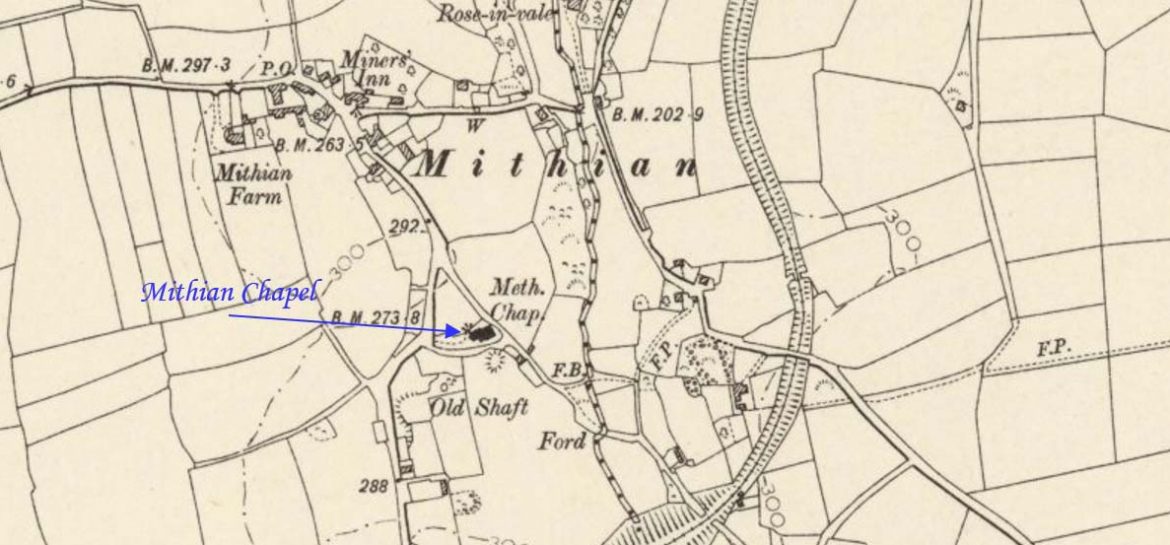
Mithian is a village about six miles northeast of Redruth and a mile east of St Agnes. This profile of Mithian Wesleyan Chapel has been compiled by Clive Benney & Tony Mansell.
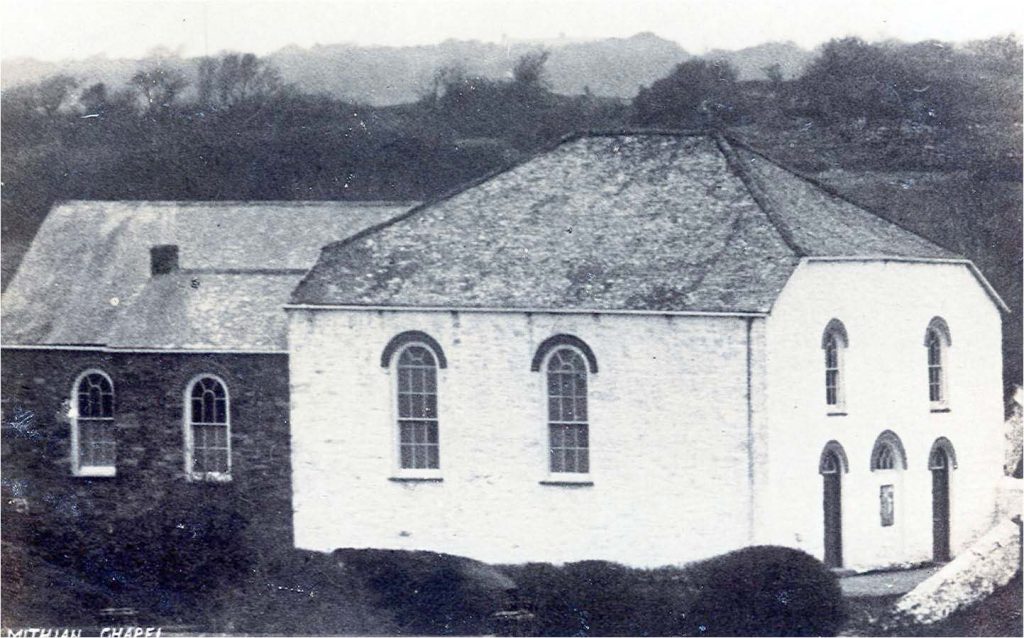 Mithian Chapel and Sunday School (Photo: courtesy Clive Benney)
Mithian Chapel and Sunday School (Photo: courtesy Clive Benney)
The date of the formation of Mithian Society where they first met remains a mystery.
1815: Mithian Sunday school active but where they met remains a mystery.
1818: Mithian Methodist Society had a membership of 85.
1819: Mithian Methodist Society in the Truro Circuit
1836: Mithian Chapel built. It was referred to as one of only two Private Trust Chapels in the St Agnes and Perranporth Circuit, the other being Mingoose. It seems that there were very few in Cornwall.
Built as a Wesleyan chapel. (SWChurches)
Wayside Wesleyan chapel, built 1800** and attached Sunday school, altered in the late C19. Now converted to house. Rubble walls with granite dressings. Very poor conversion with crude roof heightening and ugly porch addition. Listed in Stell (b1). (Cornwall Heritage Gateway) ** If correct, this could mean that there was a previous chapel on the site or that the 1836 build date relates to the Sunday school.
Jan 1894-Jun 1899: Class book, Mithian Wesleyan Chapel, St Agnes. Class leaders, James Tredinnick and Thomas Tregonning. (Kresen Kernow MRN/805)
1898: “Mithian Wesleyan Chapel was re -opened on Saturday after being renovated and re-seated. In the afternoon Dr. Wills preached, after which a public tea was held, followed later by a meeting, at which addresses were given by Dr. Wills and Messrs Rickard and Reynolds. Mr. H. Nettle presided. On Sunday the Rev. George Lester preached.” (Royal Cornwall Gazette – Thursday 18 August 1898)
The May 1903 tea treat of the Mithian Band of Hope was reported as a great success. Blackwater Band headed the members in a parade of the village following which tea was taken and various games were played. This continued until seven o’clock when the choir of the Crosscoombe Chapel gave a sacred entertainment in the chapel. It was said that a large number attended and greatly appreciated the singing of the choir. Not to be outdone, Mithian for the 1903 Wesleyans also held a tea treat for which the Foxhole Band were said to have “rendered a good selection of music”.
1903: Foxhole Brass Band played at Mithian Wesleyan Sunday school tea treat. (Royal Cornwall Gazette 2nd July 1903)
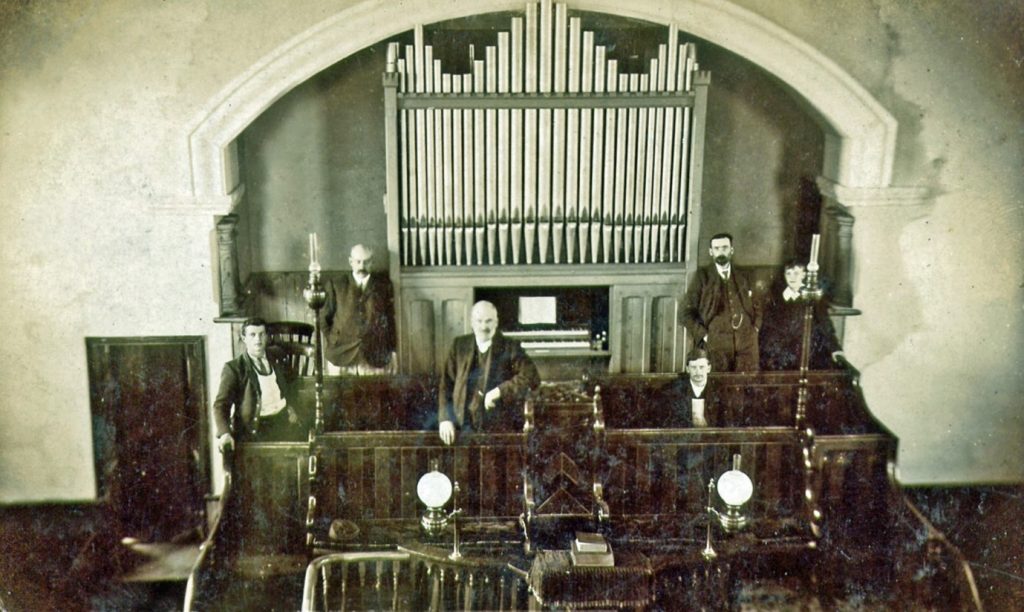 1907 Mithian Chapel Organ “opening” (Photo: courtesy Clive Benney)
1907 Mithian Chapel Organ “opening” (Photo: courtesy Clive Benney)
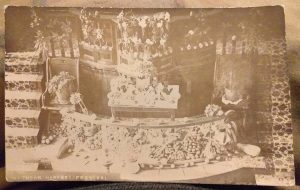 “There is something about the Harvest Festival decorations in Cornish chapels, where they do really pull out all the stops, if you will forgive the analogy. This postcard view is of the decorations of the chapel rostrum and communion area taken at the Mithian Wesleyan chapel at St Agnes in 1907, from the chapel gallery. I think that the photographer was probably Sammy Solway who was in business in the parish.
“There is something about the Harvest Festival decorations in Cornish chapels, where they do really pull out all the stops, if you will forgive the analogy. This postcard view is of the decorations of the chapel rostrum and communion area taken at the Mithian Wesleyan chapel at St Agnes in 1907, from the chapel gallery. I think that the photographer was probably Sammy Solway who was in business in the parish.
There is a profusion of fruit, flowers, vegetables and corn with the communion table having been almost completely submerged beneath this cornucopia of exuberance. I do love the two potted plants placed on the communion chairs while the rostrum itself sports a particularly garish stair carpet!
Let us not forget that the revival of the Harvest Festival (which has echoes of the medieval Lammas celebration) can be attributed to the famous vicar of Morwenstow, Robert Steven Hawker, who served there from 1834-1875. When he introduced this idea however in the autumn of 1843 the sacramental bread for the Holy Communion/Eucharist was made from the newly harvested corn. Early harvest festivals as he knew them did not have the idea of profuse decorations, such as here at Mithian, in places of worship. These ideas came later, as both Anglicans and Nonconformists developed their customs and rituals as the nineteenth century progressed and gave us the Harvest celebrations that we are more familiar with today. A lovely picture however from the Edwardian age.” (David Thomas of Kresen Kernow)
Captain John Whitford of Rose-in-Vale donated a new organ and John Tredinnick undertook the installation. At the same time new seating was installed and a general refurbishment carried out.
A good brass band was a way of ensuring a good attendance at tea treats and the little village of Mithian, near St Agnes, always had this in mind when the Wesleyans’ organising committee sat down to sort out the details. In June 1907, they managed to attract a large crowd when Camborne Town Band was present. Of course, the tea and sports were of major interest but across the years it was always felt that they had to go for the best brass band – if it was available. In 1909, the new band from St Agnes under John Paull was booked and the following year, Treviscoe Band made the long trip to be there. St Agnes Band, then under Harry Robins, were there for the 1912 Mithian Band of Hope event and just a month later, on the 27th June 1912, heavy rain completely spoilt the Wesleyans’ tea. The children had theirs outdoors but just as the tables were prepared for the teachers, elder scholars, and visitors, down came the rain. St Agnes Town Band, under Harry Robins, played during the afternoon and evening.
1919: Carharrack Temperance Band at Mithian Wesleyan Sunday School tea (Royal Cornwall Gazette 18th June 1919)
1919: On the 18th June 1919, it was Carharrack Band which was engaged for Mithian tea. This was before the incorporation of St Day to make it the Carharrack and St Day Band. (West Briton and Cornwall Advertiser 8th July 1920)
Farmer Ken Miners chatted freely about the tea treats held at Mithian in the 1930s. “I know that Camborne Band charged £11 for the day, quite a lot of money in those days. It started with the traditional parade led by the Sunday school banners. This was followed by the band and, what seemed like, the entire village. The route of the parade was from the field, circling Mithian Farmhouse, to Barkla Shop where the band would play a piece or two. It then made its way back to Rose-in-Vale where the children would be given sweets and an orange before returning to the field. Whilst the band played, there would be traditional races, Serpentine Walk, tea treat (saffron) bun and tea. Jack Chapman (father of Jack & Maurice) usually served the tea which was made in a large urn. He also supplied the buns. Several other locations were later used including the field below the chapel, (White’s field) now belonging to Geoff and Jennie Osborne, and Mrs Chapman’s chalet field. Many may remember White’s field also being referred to as Tea Treat Field.”
Several locations have been used for the Mithian Wesleyan Chapel annual tea treat but the field on the village side of Trewartha Farm became known as “Tea Treat Field”. Prior to it moving there it was held in Moor Field, by the Rose-in-Vale. When the move was made up the hill it caused some discontent and, under cover of darkness, Bill Brown and friends moved the stalls and farmers wagons, which were set up for the bandstand, back to the field at Rose-in-Vale. On the morning of the event there was the unexpected task of moving everything back up the hill again to “Tea Treat Field”.
1932: The Wesleyan, Primitive Methodist and the United Methodist Church amalgamated to become the Methodist Church of Great Britain.
1932: Became Mithian Methodist Chapel. (SWChurches)
1940: Seating for 250. (David Easton, Methodist Minister and historian)
Lavinia Hughes née Boundy was growing up in the 1950s and was delighted to recall her memories of the tea treat: “We gathered at Mithian chapel and played a few games while we waited for the procession to start. We then formed up in pairs behind the band before processing to the village and down the hill to Rose-in-Vale Hotel where the lady gave each of us some sweets from a large greaseproof, triangular bag, and her husband passed around oranges. We stayed for a while and then continued with the procession. When we arrived back at the chapel we sat on the grass bank on the left and were given paper bags containing our tea treat buns (supplied by Cowls of St Agnes, I think) and milky tea usually served by Mildred Lobb and Annie Tregenna. The tea was poured into mugs which we had brought with us: it was horrible. After that we made our way to the tea treat field. In my time there were three fields used. One was in a little three-cornered field just below the chapel, another was a little further on and on the right and the third was above the chapel, on the left as you approach the village; there was a wooden chalet there. [Presumably, the choice depended on the crop situation]. We played games and sports in the field and during the evening the band gave a concert and we ended up doing the Serpentine Walk around the field.”
1960: Was to be closed. (West Briton and Cornwall Advertiser – Thursday 22 September 1960)
Local councillor John King wrote a paper in 1965 entitled “Mithian Village”: it looked back on “times Past”. “Miners, having worked the ‘shift’ either underground or on the surface, would return home to the proverbial ‘three acres and a cow’. Although times were hard and money not always easy to come by – people were contented; the chapel was full on Sundays and Sunday school and Band-of-Hope tea treats – where sugary tea and saffron buns were the order of the day – were highlights in village life.”
Each Sunday school held its own tea treat, always hoping that it would be bigger and better than the one down the road. One way of ensuring this was to invite one of the better brass bands. Yes, it cost more, but in the words of Franklyn Ennor of Mithian referring to Camborne Town Band, “They were worth it as they made some ‘ansome sound”.
Annual tea treats are no longer held in Mithian but, like so many Cornish villages, they were once a major event in the annual calendar. The day began with the traditional parade led by the Sunday school banners followed by a brass band and, probably, the entire village. One early route of the parade was from Moor Field by the Rose-in-Vale at the bottom of the village, it circled Mithian Farmhouse, and then processed onto Barkla Shop where the band would play a piece or two. It then made its way back to Rose-in-Vale where the children would receive an orange and some sweets or nicies (5), before returning to the field. Whilst the band entertained, there were races, the distribution of tea treat buns with a cup tae (sic) and, finally, the Serpentine Walk.
1983: Mithian Chapel closed. (Rev. David Easton)
1986: The building was sold at auction and converted into two dwellings. The beautiful organ fetched only £35; there was only one bidder who just wanted the pipes.
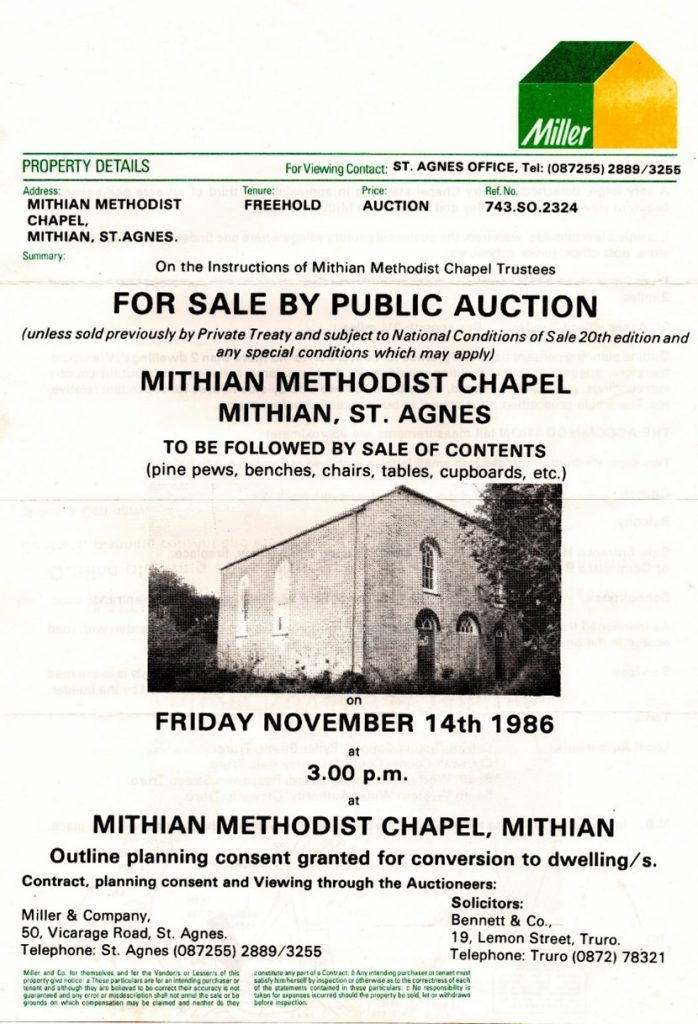
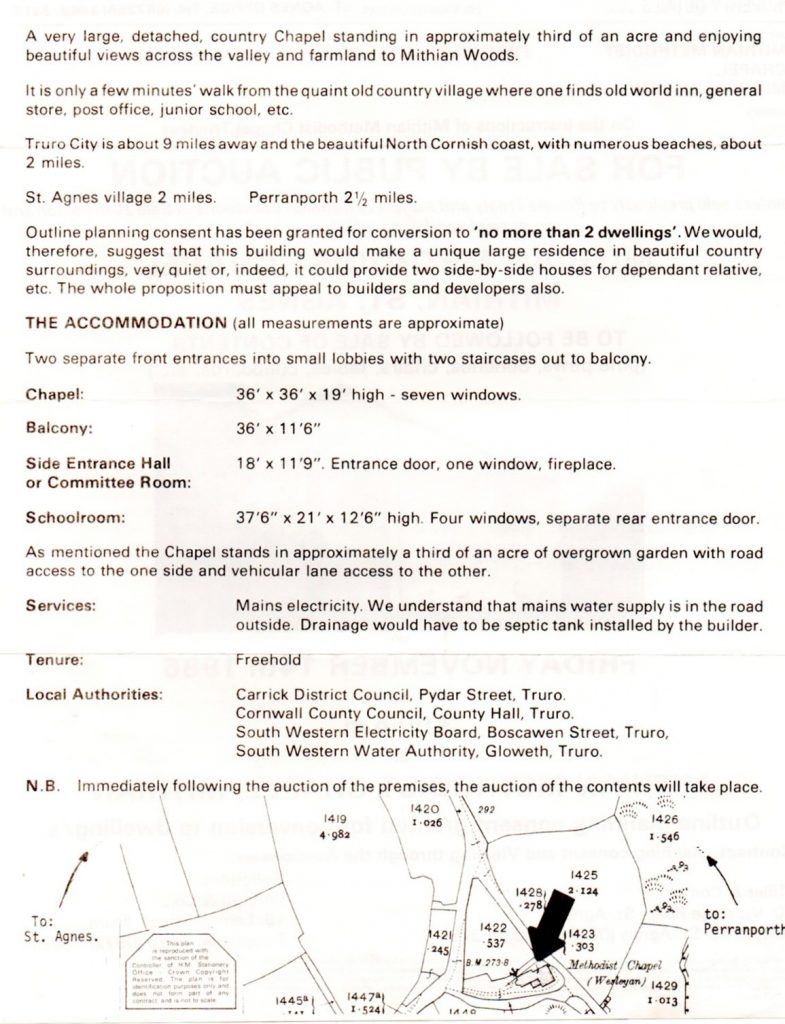
The Chapel before and after conversion
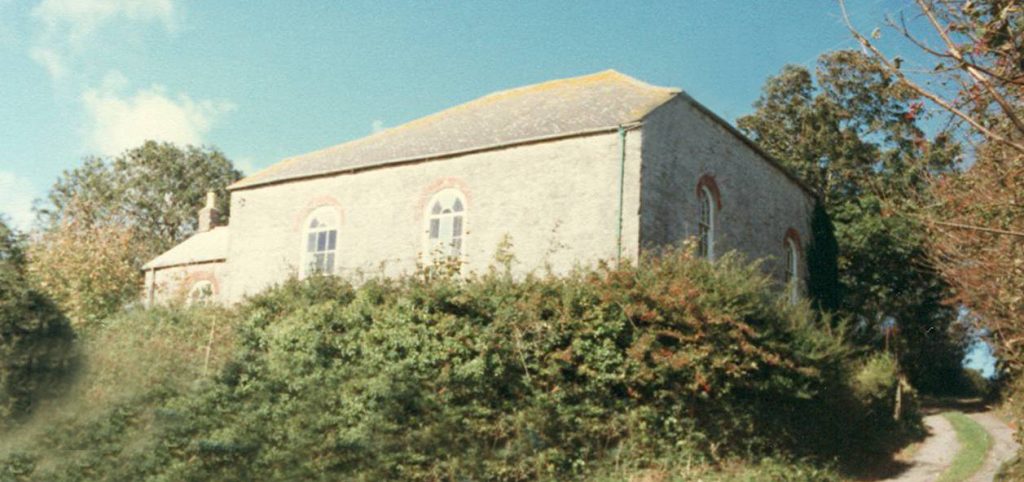 (Photo: Clive Benney)
(Photo: Clive Benney)
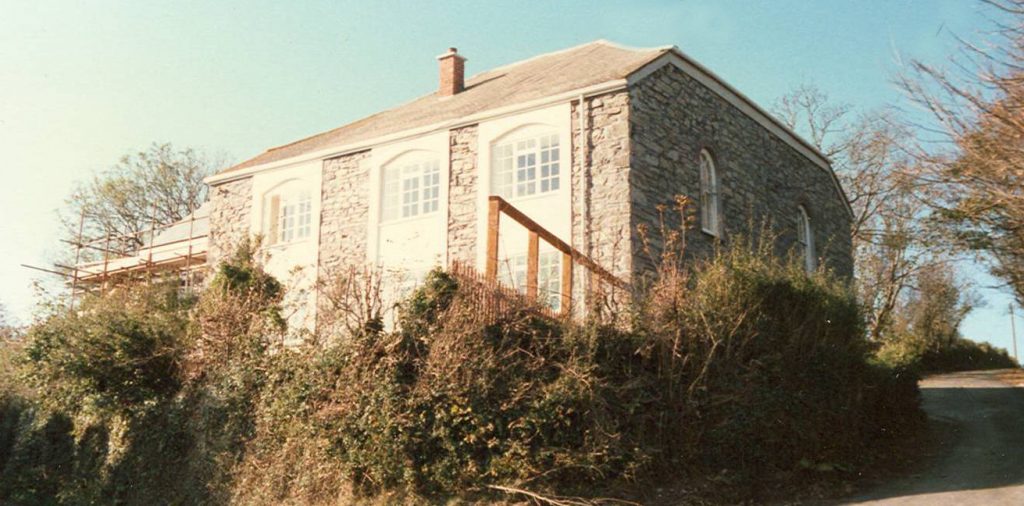 (Photo: Clive Benney)
(Photo: Clive Benney)
The Sunday school before and after conversion
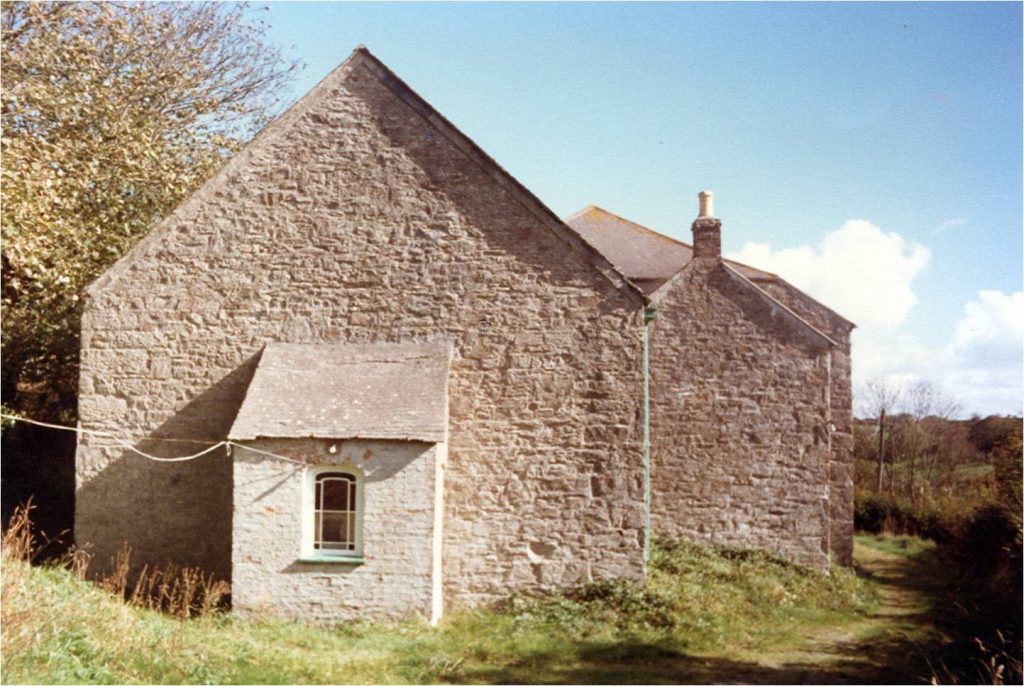 (Photo: Clive Benney)
(Photo: Clive Benney)
 (Photo: Clive Benney)
(Photo: Clive Benney)
